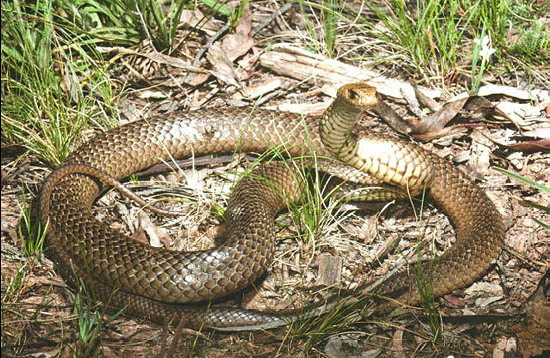|
| Query: Black & yellow warbler | Result: 2993rd of 11206 | |
Eastern Brown Snake (Pseudonaja textilis) - Wiki
| Subject: | Eastern Brown Snake (Pseudonaja textilis) - Wiki
| |

| Resolution: 550x358
File Size: 118631 Bytes
Date: 2007:01:16 11:28:17
Upload Date: 2007:01:16 11:42:59
|
Eastern brown snake
From Wikipedia, the free encyclopedia
[Photo] Adult Common Brown Snake. Photographer: Peter Robertson / Source: Wildlife Profiles Pty. Ltd.
The Eastern Brown Snake (Pseudonaja textilis) - sometimes referred to as the Common Brown Snake is the world's second most venomous land snake, native to Australia and may also be found on the peninsulas of Papua New Guinea and Indonesia
Description
Adult Eastern Brown Snakes are uniformly brown in colour. Juveniles have a black head, with a lighter band behind, a black nape, and numerous red-brown spots on the belly. Occasionally they have dark cross-bands. They have 17 rows of mid-body scales, a divided anal scale and 45???75 divided sub caudal scales. Adults generally range up to 2 metres in length.
Description
Adult Eastern Brown Snakes are uniformly brown in colour. Juveniles have a black head, with a lighter band behind, a black nape, and numerous red-brown spots on the belly. Occasionally they have dark cross-bands. They have 17 rows of mid-body scales, a divided anal scale and 45???75 divided sub caudal scales. Adults generally range up to 2 metres in length.
Behaviour
The Eastern Brown snake is diurnal, meaning it is active during the day, especially on warm sunny days where it will bask in the sun. They can be very fast moving and highly aggressive. When agitated, they will hold their necks high, appearing in a somewhat upright S-shape. The snake will occasionally chase an aggressor and strike at it repeatedly.
Diet
Its diet consists of eggs and small mammals; especially rodents such as mice and rats and may also eat other reptiles and frogs.
Venom
The Eastern Brown Snake is the second most venomous land snake in the world after the Inland Taipan.[1] Although Eastern Browns will seek to avoid a confrontation, it has a very toxic venom, and when bitten can cause death. Sub-adults have been known to cause fatalities in humans. The venom contains both neurotoxins and blood coagulants.
Reproduction
Eastern Brown Snakes mate during spring. where males can be found to engage in 'ritual combat' with another male to dominate and displace the other's territory. The most dominant male will mate with females in the area, to which the female will produce a clutch of 10-40 eggs in late spring or early summer.
http://en.wikipedia.org/wiki/Eastern_brown_snake
| The text in this page is based on the copyrighted Wikipedia article shown in above URL. It is used under the GNU Free Documentation License. You may redistribute it, verbatim or modified, providing that you comply with the terms of the GFDL. |
|
Comments |
|---|
| | mbbs_muthu |
|
| nan polllathavan |

|

|

|
Black & yellow warbler
2993/11206 |

|

|
^o^
Animal Pictures Archive for smart phones
^o^
|
|
|

